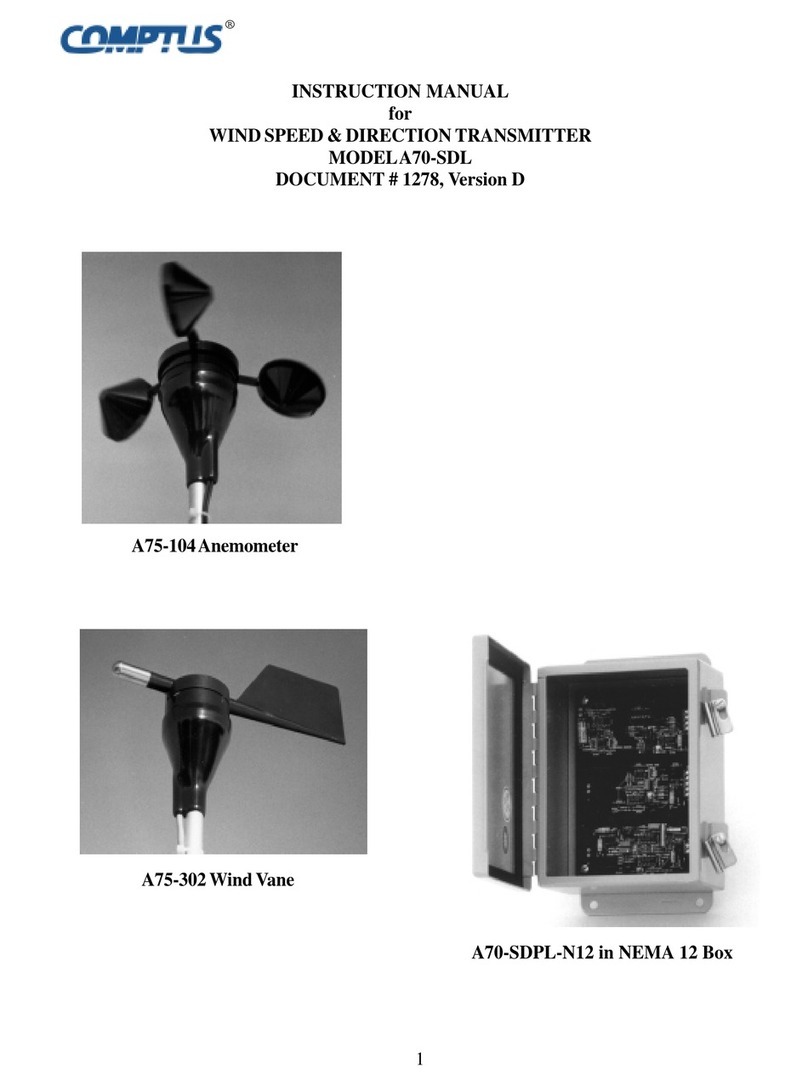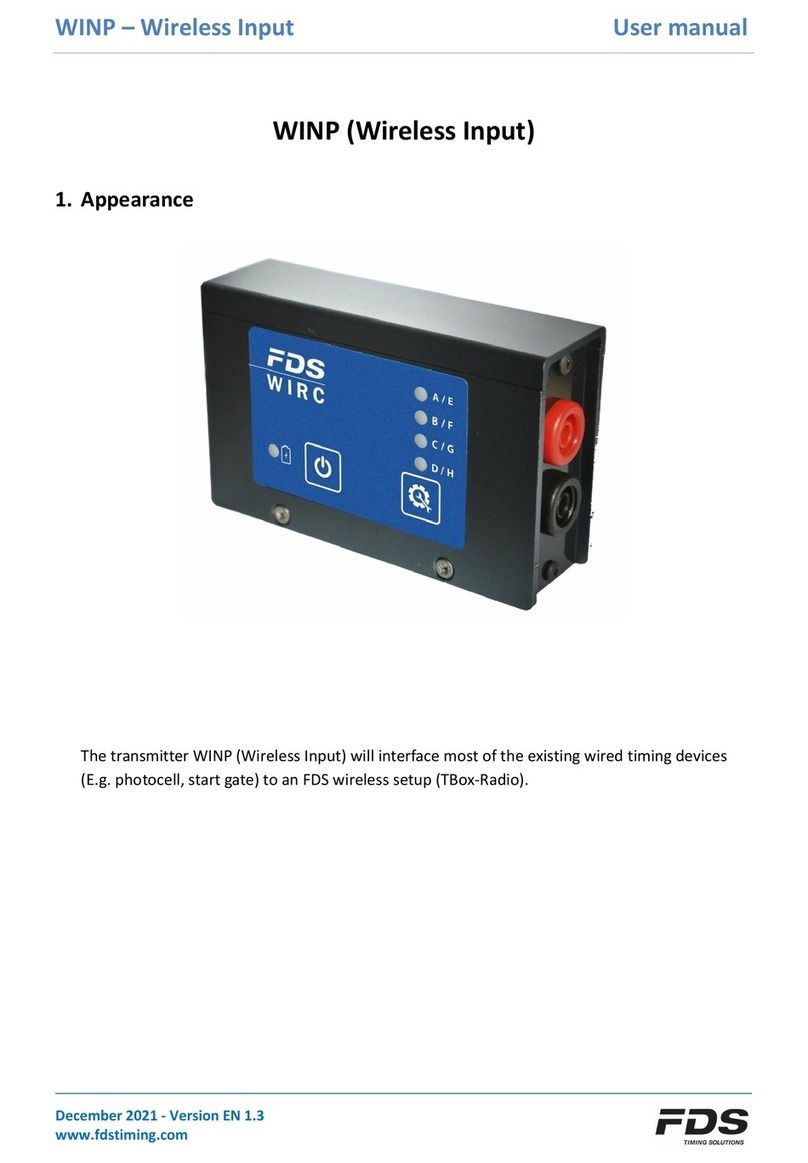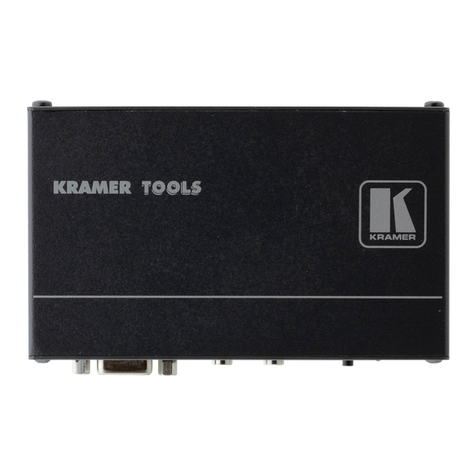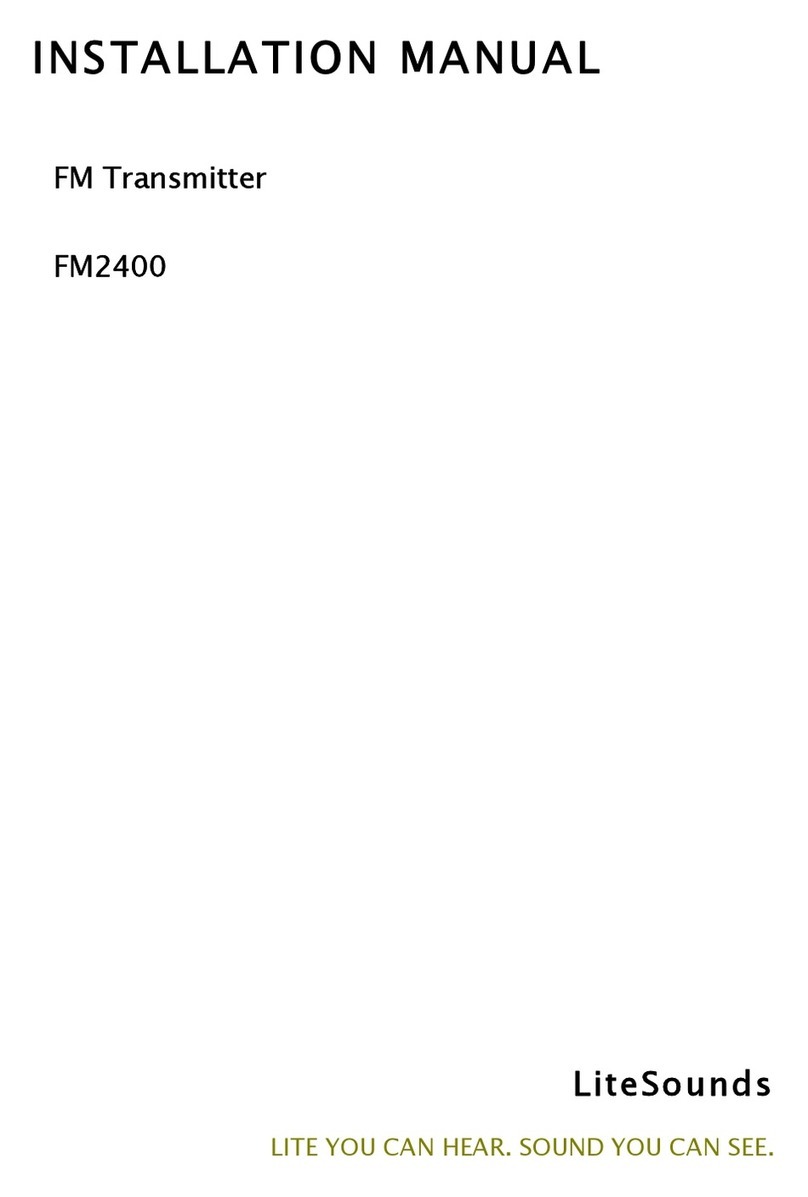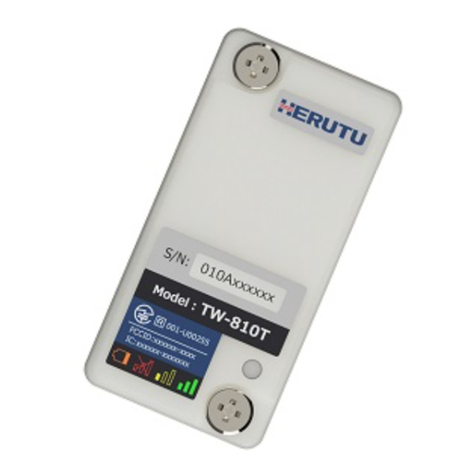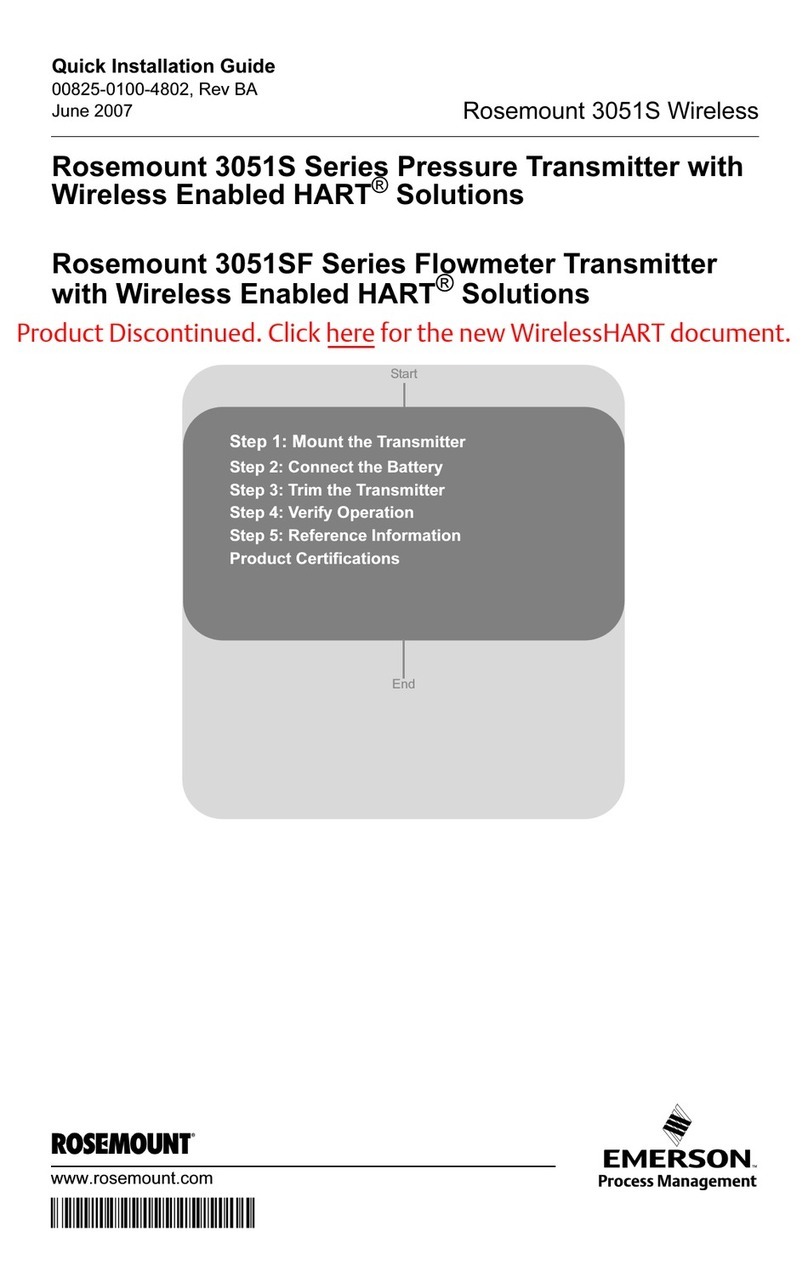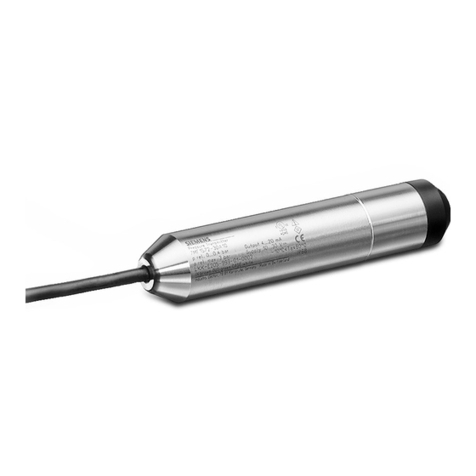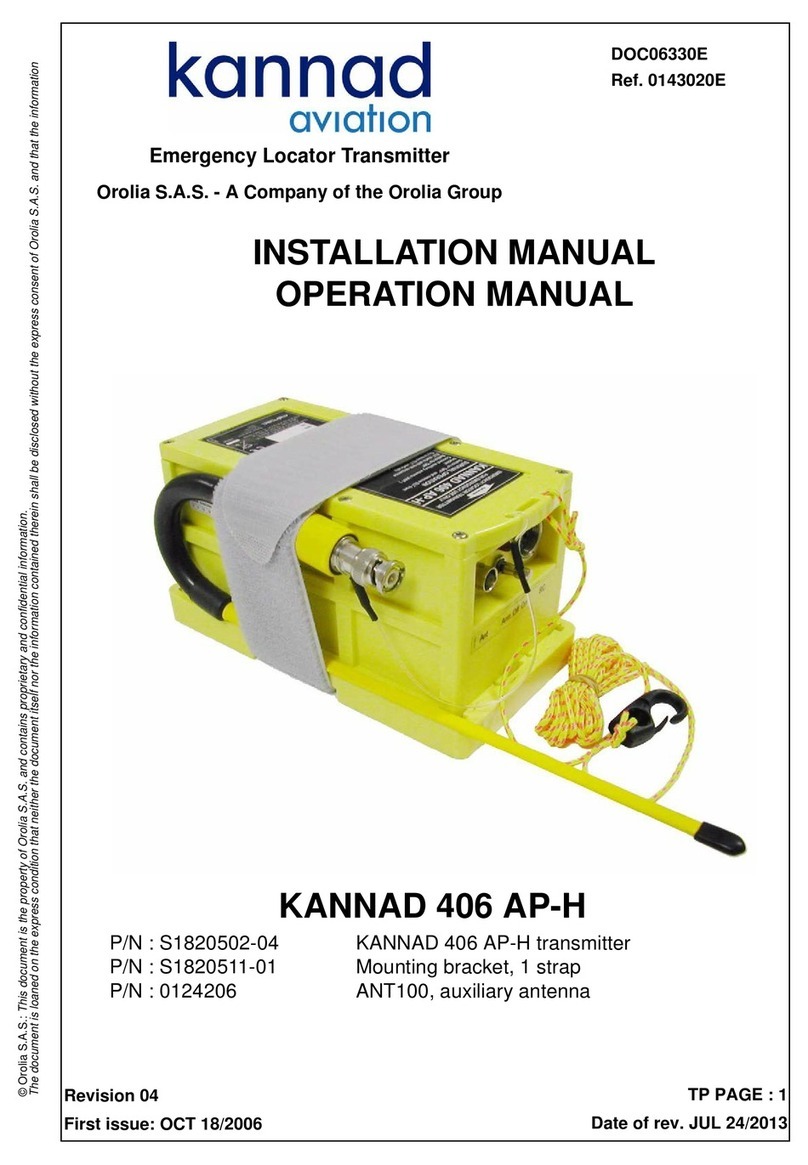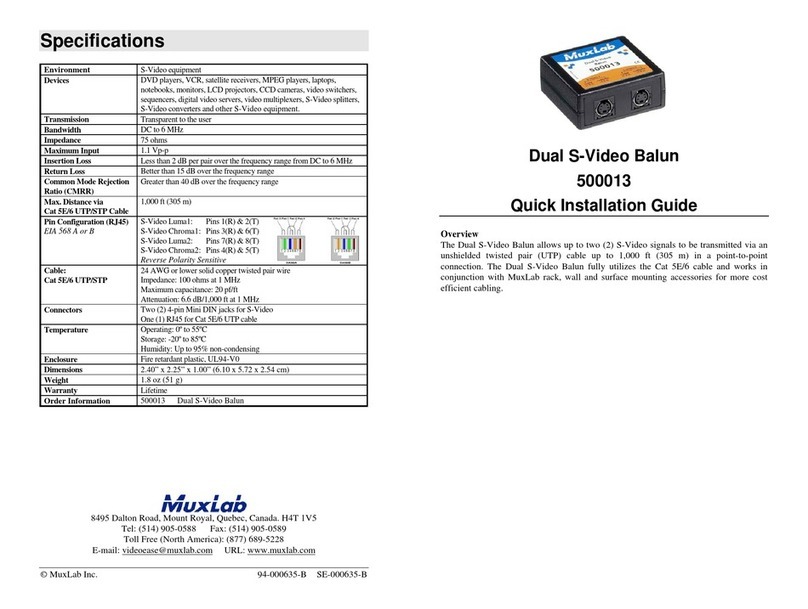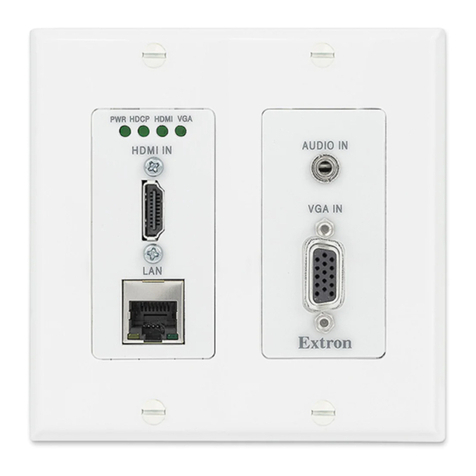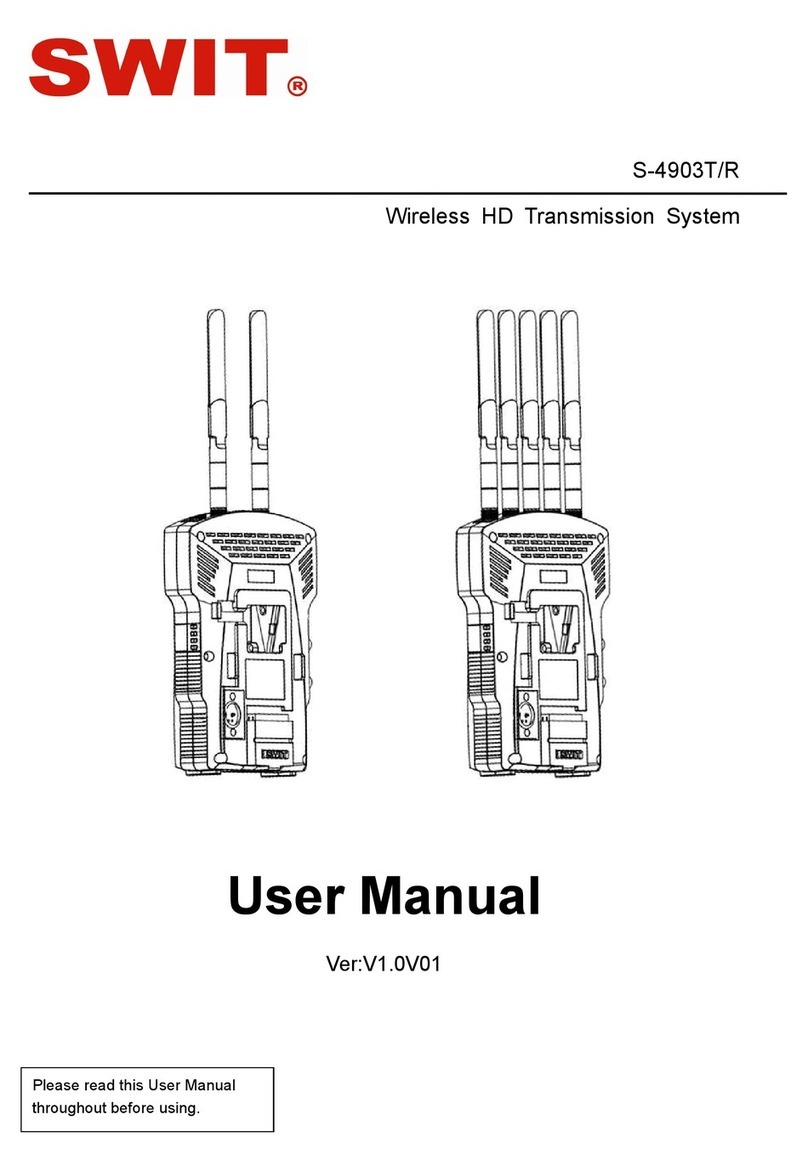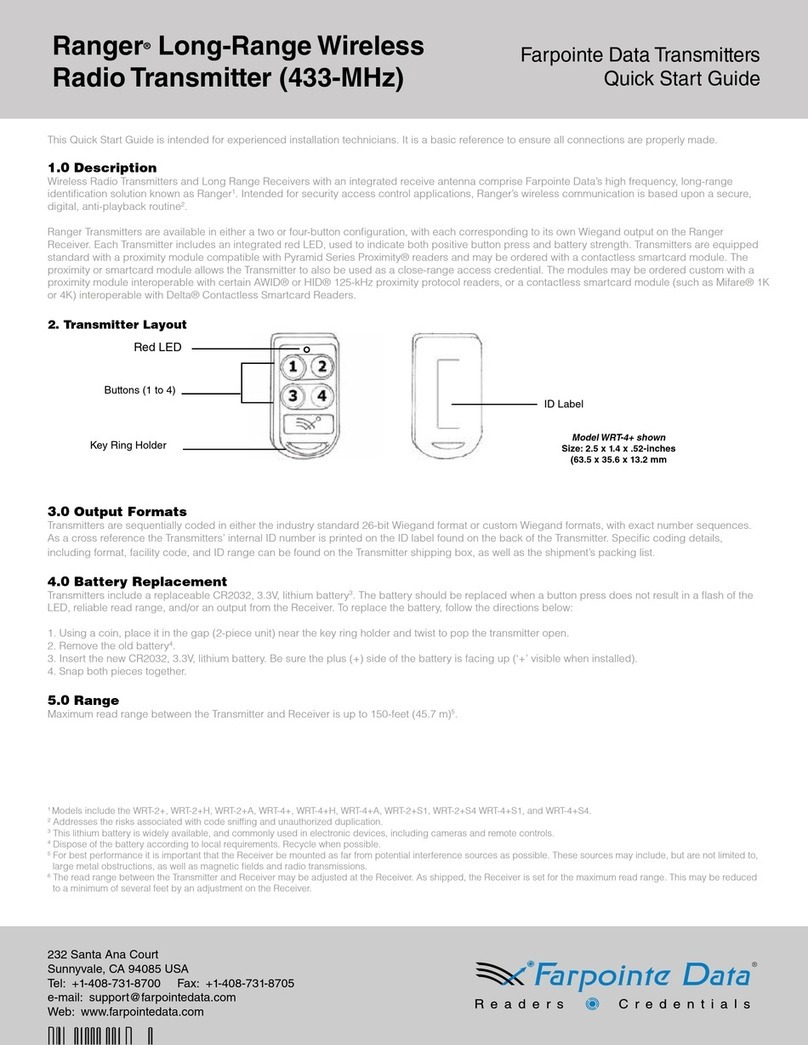GF Signet 8850-3 User manual

SIDE VIEW
Field Mount w/
8052 Integral kit
92 mm
(3.6 in.)
97 mm
(3.8 in.)
56 mm
(2.2 in.)
41 mm
(1.6 in.
)
Optional
Rear
Cover
Panel Mount
SIDE VIEW
FRONT VIEW
96 mm
(3.8 in.)
96 mm
(3.8 in.)
Field Mount &
Panel Mount
SIDE VIEW
Field Mount w/
8050 Universal base
106 mm (4.2 in.)
42 mm
(1.7 in.)
64 mm
(2.5 in.)
82 mm
(3.23 in.)
8050
96 mm
(3.8 in.)
107 mm (4.2 in.)
42 mm
(1.7 in.)
65 mm
(2.5 in.)
8052
Signet 8850-3 Conductivity/Resistivity Transmitter
2. Specifications
General
Compatible electrodes: Signet 3-28XX-1 Standard and Certified
Series Conductivity/Resistivity Electrodes
Accuracy: ±2% of reading
Enclosure:
• Rating: NEMA 4X/IP65 front
• Case: PBT
• Panel Case Gasket: Neoprene
• Window: Polyurethane coated polycarbonate
• Keypad: Sealed 4-key silicone rubber
• Weight: Approx. 325g (12 oz.)
Display:
• Alphanumeric 2 x 16 LCD
• Contrast: User selected, 5 levels
• Update rate: 1.8 seconds
Electrical
• Power: 12 to 24 VDC ±10%, regulated, 100 mA max.
Sensor input range:
• Conductivity: 0.01 μS/cm to 400 000 μS/cm
• Resistivity: 10 K•cm to 100 M•cm
• TDS: 0.023 to 200 000 PPM nominal (adjustable μS/PPM)
• Temperature: PT 1000, -25 °C to 120 °C (-13 °F to 248 °F)
Measurements above 10 M(below 0.1 μS) must be performed
in solution temperatures from 20 °C to 100 °C.
Two 4 to 20 mA Outputs:
• Passive, isolated, fully adjustable and reversible 4 to 20 mA
outputs are independently source selectable for conductivity or
temperature.
• Max Loop Impedance: 50 max. @ 12 V
325 max. @ 18 V
600 max. @ 24 V
• Update Rate: 200 ms
• Accuracy: ±0.03 mA @ 25°C, 24 V
Open-collector output, optically isolated:
• 50 mA max. sink, 30 VDC maximum pull-up voltage.
• Programmable for:
• High or Low with adjustable hysteresis
• Pulse operation (max rate: 400 pulses/min).
Environmental
Operating Temperature: -10 °C to 70 °C (14 °F to 158 °F)
Storage Tmperature: -15 °C to 80 °C (5 °F to 176 °F)
Relative Humidity: 0 to 95%, non-condensing
• Maximum Altitude: 2000 m (6562 ft)
• Insulation Category: II
• Pollution Degree: 2
Standards and Approvals
• CE, UL listed
• Manufactured under ISO 9001 for Quality, ISO 14001 for
Environmental Management and OHSAS 18001 for Occupational
Health and Safety.
China RoHS (Go to www.gfsignet.com for details)
Declaration of Conformity according to FCC Part 15
This device complies with Part 15 of the FCC rules. Operation is
subject to the following two conditions:
(1) This device may not cause harmful interference, and,
(2) This device must accept any interference received, including
interference that may cause undesired operation.
Signet
Conductivity/Resistivity
Transmitter
ENTER
62.50 uS/cm
25.0 C
CAUTION!
• Remove power to unit before wiring
input and output connections.
• Follow instructions carefully to avoid
personal injury.
Contents
1. Installation
2. Specifications
3. Electrical Connections
4. Menu Functions
1. Installation
ProcessPro transmitters are available in two styles: panel mount and field mount. The panel mount is supplied with the necessary
hardware to install the transmitter. This manual includes complete panel mounting instructions.
Field mounting requires a separate mounting kit. The 3-8050 Universal kit enables the transmitter to be installed virtually
anywhere. Detailed instructions for field installation options are included with the 3-8050 Universal kit.
1.1 Panel Installation
1. The panel mount transmitter is designed for installation using a 1/4 DIN Punch. For manual panel cutout, an adhesive
template is provided as an installation guide. Recommended clearance on all sides between instruments is 1 inch.
2. Place gasket on instrument, and install in panel.
3. Slide mounting bracket over back of instrument until quick-clips snap into latches on side of instrument.
4. To remove, secure instrument temporarily with tape from front or grip from rear of instrument. DO NOT RELEASE.
Press quick-clips outward and remove.
3-8850.090-3 Rev. K 11/12 English
*3-8850.090-3*
English

2 8850-3 Conductivity/Resistivity Transmitter
14
13
12
11
Shield (Sensor Gnd)
Black (Iso Gnd)
White (Temp In)
Red (Signal In)
Signet 28XX-1
Standard and Certified Cells
Terminals
3.1 Sensor Input Connections
≤ 30 m (100 ft)
Signet
Conductivity/Resistivity
Transmitter
ENTER
62.50 uS/cm
25.0 C
Sensr Gnd
(SHIELD)
Iso. Gnd
(BLACK)
Temp. IN
(WHITE)
Signal IN
(RED)
14
13
12
11
Output 2-
Output 2+
Output 1-
Output 1+
10
9
8
7
Loop 2-
Loop 2+
System Pwr
Loop -
System Pwr
Loop +
AUX
Power -
AUX
Power +
6
5
4
3
2
1
3. Electrical Connections
Caution: Failure to fully open terminal jaws before removing wire may permanently damage instrument.
Wiring Procedure
1. Remove 0.5 to 0.625 in. (13 to16 mm) of insulation from wire end.
2. Press the orange terminal lever downward with a small screwdriver to open terminal jaws.
3. Insert exposed (non-insulated) wire end in terminal hole until it bottoms out.
4. Release orange terminal lever to secure wire in place. Gently pull on each wire to ensure a good connection.
Wiring Removal Procedure
1. Press the orange terminal lever downward with a small screwdriver to open terminal jaws.
2. When fully open, remove wire from terminal.
Wiring Tips:
• Do not route sensor cable in conduit containing AC power wiring. Electrical noise may interfere with sensor signal.
• Routing sensor cable in grounded metal conduit will help prevent electrical noise and mechanical damage.
• Seal cable entry points to prevent moisture damage.
• Only one wire should be inserted into a terminal. Splice double wires outside the terminal.
2
1
Terminals 7-10: Open-collector Outputs
• Two transistor outputs, programmable as:
• High or Low setpoint with adjustable hysteresis
• Proportional Pulse (to 400 pulses per minute maximum)
• May be disabled (Off) if not used
Terminals 3–6: Loop Power
12 to 24 VDC ±10% system power
and current loop output.
Max. loop impedance:
50 max. @ 12 V
325 max. @ 18 V
600 max. @ 24 V
Terminals 11–14: Sensor Input
11 is conductivity input
12 is temperature input
13 is the isolated signal ground
14 is the sensor earth ground
Terminals 1–2: Auxiliary power
Provides DC power to measurement
circuit. Required for all 8850 systems 1
Internal open-collector
output circuit Outputs
Isolation
15 Ω
S
D
2
_
+

38850-3 Conductivity/Resistivity Transmitter
3.2 System Power/Loop Connections
S
tand-alone application, no current loop used
Transmitter
Terminals
Power
Supply
12 to 24 VDC
Connection to a PLC with built-in power supply
Internal
PLC
Connection
Connection to a PLC/Recorder, separate supply
Example: Two transmitters connected to PLC/Recorder with separate power supply
-
+
PLC or Recorder
Loop 2 -
Loop 2 +
System Power Loop 1 -
System Power Loop 1 +
AUX Power -
AUX Power +
6
5
4
3
2
1
Transmitter
Terminals
Loop 2 -
Loop 2 +
System Power Loop 1 -
System Power Loop 1 +
AUX Power -
AUX Power +
6
5
4
3
2
1
6
5
4
3
2
1
Transmitter
Terminals
Loop 2 -
Loop 2 +
System Power Loop 1 -
System Power Loop 1 +
AUX Power -
AUX Power +
Loop 2 -
Loop 2 +
System Power Loop 1 -
System Power Loop 1 +
AUX Power -
AUX Power +
6
5
4
3
2
1
6
5
4
3
2
1
Loop 2 -
Loop 2 +
System Power Loop 1 -
System Power Loop 1 +
AUX Power -
AUX Power +
Power
Supply
12 to 24 VDC
-
+
PLC or Recorder
Channel 3
4 to 20 mA in
Channel 4
4 to 20 mA in
-
+
-
+
Transmitter 1
Terminals
Transmitter 2
Terminals
PLC Terminals
Channel 1
4 to 20 mA
+
-
Power
Supply
12 to 24 VDC
Channel 2
4 to 20 mA
+
-
-
+
Channel 2
4 to 20 mA
+
-
Channel 1
4 to 20 mA
-
+
Channel 1
4 to 20 mA in
Channel 2
4 to 20 mA in
+
-
+
-
Power
Supply
12 to 24 VDC
-
+
NC
NC
AUX power required for all 8850 systems
1mS
1MΩ
10mS
100KΩ
1,000mS 10,000mS
50,000mS 200,000mS
100mS
10KΩ
400,000mS
100,000mS
0.054mS
18.3 MΩ
Bottled
Water
Brackish Sea Water
(Salinity)
UPW @ 25°C
USP
Cooling Tower
Waste Waters
Deionization Regen. Chemicals
Alkali Cleaners, Acids/Bases
Rinse
Water
3-2819, 3-2839 (0.01 Cell)
3-2820, 3-2840 ( 0.10 Cell)
3-2821, 3-2841 (1.0 Cell)
3-2822, 3-2842 (10.0 Cell)
3-2823 (20.0 Cell)
0.010mS
100 MΩ
200mS
Select the sensor with the range that best straddles your
application requirements.
• 2818-1, 2839-1 (0.01 cell): 0.01 to 100 μS/cm
(10 kΩto 100 MΩ)
Use the 2818-1 or the 2839-1 for all resistivity requirements
• 2820-1, 2840-1 (0.1 cell): 1 to 1000 μS/cm
• 2821-1, 2841-1 (1.0 cell): 10 to 10,000 μS/cm
• 2822-1, 2842-1 (10.0 cell): 100 to 200,000 μS/cm
• 2823-1 (20.0 cell): 200 to 400,000 μS/cm

4 8850-3 Conductivity/Resistivity Transmitter
Signet
Conductivity/Resistivity
Transmitter
ENTER
62.50 uS/cm
25.0 C
VIEW menu
• During normal operation, ProcessPro displays the VIEW menu.
• When editing the CALIBRATE or OPTIONS menus, ProcessPro will return to the VIEW menu if no activity
occurs for 10 minutes.
• To select a VIEW display, press the UP or DOWN arrow keys. The selections will scroll in a continuous loop.
• Changing the VIEW display does not interrupt system operations.
• No key code is necessary to change display selection.
• Output settings cannot be edited from the VIEW menu.
Hysteresis
Time
Low Setpoint
Process
Relay energized
Relay relaxed
Hysteresis
Time
High Setpoint
Process
View Menu
Display Description
10
5
Open Collector Output Rate:
0 to 100 Pulses/min.
endpoint
Pulse rate
0 pulses
100 pulses
Starting point
•Proportional Pulsing
The Open Collector output will generate a 100 mS pulse at the
rate defined by settings in the CALIBRATE menu.
In the example below:
• The output will be 0 pulses/min. when value is less than 5.
• The output will be 50 pulses/min. when value is 7.5.
• The output will be 100 when value is greater than 10.
The starting point, endpoint and maximum pulse rate are
selectable in the CALIBRATE menu.
3.3 Open Collector Outputs
The Open Collector output can be used as a switch that responds
when the process value moves above or below a setpoint, or it
can be used to generate a pulse at a rate proportional to the
process value.
• Low:
Output triggers when process variable is less than the setpoint.
The output will relax when the process variable moves above the
setpoint plus the hysteresis value.
• High:
Output triggers when process variable is greater than the
setpoint. The output will relax when the process variable moves
below the setpoint plus the hysteresis value.
123.45 μS/cm
67.89 ºC
Monitor the Conductivity and temperature values from the sensor.
This is the Permanent display.
Monitor the Loop Current output.
Monitor the Loop2 Current output.
Check the Last Calibration date.
The VIEW displays below are temporary. The permanent display will return after 10 minutes
Loop1 Output:
13.75 mA
Loop2 Output:
13.75 mA
Last CAL:
04-20-10

58850-3 Conductivity/Resistivity Transmitter
Notes on Steps 5 and 6:
• All output functions remain active during editing.
• Only the flashing element can be edited.
• RIGHT ARROW key advances the flashing element in a continuous loop.
• Edited value is effective immediately after pressing ENTER key.
• If no key is pressed for 10 minutes unit will restore the last saved value and return to step 3.
• Step 6 (pressing ENTER key) always returns you to Step 3.
• Repeat steps 3-6 until all editing is completed.
Notes on Step 2:
If no key is pressed for 5 minutes while display is showing "Enter
Key Code", the display will return to the VIEW menu.
Notes on Steps 3 and 4:
• Refer to pages 6 and 7 for complete listing of menu items and their use.
• From the Step 3 display, pressing the UP and DOWN keys simultaneously will
return the display to the VIEW menu.
• If no key is pressed for 10 minutes, display will also return to the VIEW menu.
ProcessPro Editing Procedure:
Step 1. Press and hold ENTER key:
• 2 seconds to select the CALIBRATE menu.
• 5 seconds to select the OPTIONS menu.
Step 2. The Key Code is UP-UP-UP-DOWN keys in sequence.
• After entering the Key Code, the display will show the first item in the selected menu.
Step 3. Scroll menu with UP or DOWN arrow keys.
Step 4. Press RIGHT ARROW key to select menu item to be edited.
• The first display element will begin flashing.
Step 5. Press UP or DOWN keys to edit the flashing element.
• RIGHT ARROW key advances the flashing element.
Step 6. Press ENTER key to save the new setting and return to Step 3.
OPTIONS
CALIBRATE
VIEW
2s 5s
Press &
hold for
access:
ENTER
Step 5
Step 6
Notes on Step 1:
• The View Menu is normally displayed.
• The CALIBRATE and OPTIONS menus require a KEY CODE.
Step 4
First item in
CALIBRATE menu
Step 3
Step 3: Finished Editing?
Press the UP and DOWN keys simultaneously after
saving the last setting to return to normal operation.
Press the UP and DOWN keys simultaneously
while any element is flashing. This will recall the
last saved value of the item being edited and
return you to Step 3.
Step 5: Made an Error?
Output1 Setpnt:
20.00 uS
Output1 Setpnt:
10.00 uS
ENTER
Output1 Setpnt:
10.00 uS
Output1 Setpnt:
1
9
.00 uS
Output1 Setpnt:
Saving
Output1 Setpnt:
19.00 uS >
20.0 uS >
Output1 Setpnt:
Standard >
Cell Constant:
CALIBRATE: ----
Enter Key Code
CALIBRATE: *---
Enter Key Code
CALIBRATE: **--
Enter Key Code
CALIBRATE: ***-
Enter Key Code
Standard >
Cell Constant:

6 8850-3 Conductivity/Resistivity Transmitter
Select CUSTOM only if you are connecting a certified conductivity sensor. Select STANDARD
for all other systems.
For STANDARD sensors: Select from these options: 0.01, 0.1, 1.0, 10.0 or 20.0.
For CUSTOM sensors: Enter the precise cell constant from the certificate provided with your
sensor, or from the information label on the sensor.
Select from the following options: μS, mS, kΩ, MΩ, PPM.
If the Units selection is PPM, you can set the ratio of Total Dissolved Solids to μS. See
section 3 of this manual for additional information. The TDS factor can only be set in PPM.
Adjust the temperature of the system based on an accurate external reference.
For use with STANDARD sensors: Perform this single-point wet calibration for most accurate
results. Not required for CUSTOM sensors except for periodic system accuracy confirmation.
Enter all zeroes to restore factory calibration to TEMP and COND settings.
Select the input source to be associated with the current loop output: Conductivity or
Temperature.
Select the minimum and maximum values for the current loop output.
Be sure to modify this setting if you change the Cond. Units.
Select the source for the Open Collector output: Conductivity or Temperature.
Select the mode of operation for the Open Collector output.
Options available are High, Low or proportional Pulse.
The signal may be disabled (Off) if not in use.
In Low or High Mode, this Open Collector output will be activated when the process reaches
this value. Be sure to modify this setting if you change the Cond. Units.
The Open Collector output will be deactivated at Setpoint ± Hysteresis, depending on High or
Low Setpoint selection. (See details on page 4.)
In Pulse mode, set the process values where the proportional pulse will start and where it will
reach the maximum rate. Be sure to modify this setting if you change the Cond. Units.
In Pulse mode, set the maximum rate for the proportional Pulse output. The 8850 will accept
any value from 0 to 400.
Use this “note pad” to record important dates, such as annual recertification or scheduled
maintenance.
Calibrate Menu
Display
(Factory settings shown) Description
Cell Constant:
Standard >
Cell: Standard
1 >
Cell: Custom
1.0000 >
Cond Units:
uS >
PPM Factor:
2.00 >
Set:
Temperature >
Set:
Conductivity >
Loop1 Source:
Cond >
Loop1 Range: uS
0.0000 →100.000 >
Output1 Source:
Cond >
Output1 Mode:
Low >
Output1 Setpnt:
10.0000 uS >
Output1 Hys:
0.5000 uS >
Output1 Rng: uS
10.0000 →40.0000 >
Output1 PlsRate:
120 Pulses/Min >
Last CAL:
04-20-10 >
Settings will repeat for Loop 2 and Output 2.

78850-3 Conductivity/Resistivity Transmitter
Contrast:
3 >
Cond Decimal:
****.* >
Averaging
Off >
Loop1 Adjust:
4.00 mA >
Loop1 Adjust:
20.00 mA >
Temp Display:
ºC >
Temperature
Comp %: 2.00 >
Output1 Active:
Low >
Test Loop 1:
>
Test Output 1:
>
Adjust the LCD contrast for best viewing. A setting of 1 is lower contrast, 5 is higher. In
general, select lower contrast if the display is in warmer ambient surroundings.
Set the decimal to the best resolution for your application. The display will automatically
scale down to this restriction. Select *****., ****.*, ***.** **.*** or *.**** .
OFF provides the most instantaneous response to process changes. Select LOW (4 sec)
or HIGH (8 sec) averaging if your process experiences frequent or extreme fluctuations.
Adjust the minimum and maximum current output. The display value represents the
precise current output. Adjustment limits:
• 3.80 mA < 4.00 mA > 5.00 mA
• 19.00 mA < 20.00 mA > 21.00 mA
Use this setting to match the system output to any external device.
Select ºC or ºF.
Set the percent change in Conductivity caused by a 1ºC change in temperature. May be
from 0.00 to 10.00.
Active HIGH: This setting is used to turn a device (pump, valve) ON at the setpoint.
Active LOW: This setting is used to turn a device OFF at the setpoint.
Press UP and DOWN keys to manually order any output current value from
3.8 mA to 21.00 mA to test the output loop.
Press UP and DOWN keys to manually toggle the Open Collector output state.
Options Menu
Display
(Factory settings shown) Description
Settings will repeat for Loop 2 and Output 2.

8 8850-3 Conductivity/Resistivity Transmitter
Calibration Procedure
This instrument has been electronically calibrated at the factory.
• Procedure A verifies the accuracy and linearity of the instrument by simulating temperature and conductivity values with precision
(±0.1%) fixed resistors.
• Procedure B is a wet calibration. This procedure uses the sensor input and NIST traceable test solutions. When done correctly, this
procedure offers the most accurate system calibration.
Iso. Gnd
(BLACK)
Temp. IN
(WHITE)
Signal IN
(RED)
13
12
11 Simulation resistor
TC resistor
B) Wet Calibration with NIST Traceable Solutions:
When using NIST traceable standards, review the temperature information provided with the test solution. Prevent contamination of the
test solution. The sensor must be at the temperature specified on the test solution label.
• Remove the sensor from the system. Rinse the sensor in a small amount of test solution.
• Place the sensor into the test solution.
• Place a reference thermometer into the same solution.
• Allow sufficient time for the temperature to stabilize.
• Set Temp: Adjust the temperature value based on the reference thermometer. (see Editing Procedure.)
• Set Cond: Adjust the conductivity value based on the test solution value. (see Editing Procedure.)
• Verify the linearity by placing the sensor into a second test solution of a different value.
• If the instrument does not display the correct value (Temperature ± 0.5 ºC, Conductivity ± 2% of reading), service is required.
A) Accuracy Verification with Precision Resistors (Electronic Calibration):
1. Simulate the Temperature
The temperature input to the 8850 is a PT-1000 thermistor, where 1000 Ohms () is equal to 0 ºC and a change of 3.84 equals a
1 ºC change. (1000 = 0 ºC, 1003.84 = 1.0 ºC, 1007.68 = 2.0 ºC...................1096 = 25 ºC)
• Connect a resistor (1000 to 1096 ) between "Temp IN" and "Iso. Gnd" terminals.
• Set Temp; Adjust the temperature to exact value based on the measured resistance. (see Editing Procedure, Calibrate menu).
• To verify the temperature linearity, connect a second resistor value to the terminals.
• If the instrument does not display the correct value, service is required. ( ± 0.5ºC)
2. Simulate the Conductivity
You may calculate the exact Resistance needed to simulate a specific conductivity value , or you may calculate the exact Conductivity
based on a resistor value:
Resistance = Cell constant e.g. 0.1 Cell = 5,000 or 5 K
conductivity (Siemens*) 0.000020 (Siemens*)
Conductivity = Sensor cell e.g. 0.1 Cell = 0.000001 Siemens*
Simulation resistance (Ω) 100,000 (Ω) or 1μS/cm
(*1 μS = 1 X 10-6 Siemens or 0.000001 Siemens)
• Connect the conductivity resistor between the "Signal IN " and "Iso Gnd" terminals.
• Set Cond: Adjust the conductivity value based on the resistor value. (see Editing
Procedure and Calibrate menu).
• Verify the linearity of the instrument by connecting a second resistor of a different value.
• If the instrument does not display the correct value (± 2% of reading), service is required.

98850-3 Conductivity/Resistivity Transmitter
Parts Per Million (PPM) Factor
This feature is only applicable when PPM display units are selected. The programmable PPM Factor is adjustable from 0.01 to
3.00 (factory default = 2.00).
Determine the best PPM Factor for a process solution by calculating the solution's conductivity (μS) and the percent of total
dissolved solids (PPM).
PPM Factor = Solution conductivity (μS/cm)
Total dissolved solids (PPM)
TDS (PPM) = Solution conductivity (μS/cm)
PPM Factor
Example: • Solution conductivity = 400 μS/cm
• TDS = 200 PPM (mg/L)
PPM Factor = 400 μS/cm = 2.00
200 PPM
Temperature Coefficient
Conductivity measurement is highly dependent on temperature. Temperature dependence is expressed as the relative change per °C,
commonly known as percent/°C change from 25 °C, or slope of the solution.
Slopes can vary significantly depending on process solution type. The factory default temperature compensation factor is 2.00%/°C.
Process solutions may require adjustment for maximum accuracy. To determine the optimum temperature compensation factor for a
process:
1. Disable the 8850 temperature compensation % factor by entering 0.00.
2. Heat the sample solution close to the maximum process temperature. Place sensor in the sample solution allowing several
minutes for stabilization. Access the VIEW menu and record the displayed temperature and conductivity values in the spaces
provided:
Displayed temperature: T1 = _______ °C
Displayed conductivity: C1 = _______ μS
(Do not use this procedure for solutions from 0.055 μS to 0.1 μS (10 Mto 18 M). An internal pure water curve is used for these
ranges. The factory default setting of 2.00%/°C should be used.)
3. Cool the sample solution close to the minimum process temperature. Place sensor in the sample solution allowing several
minutes for stabilization. Record displayed temperature and conductivity values in the spaces provided:
Displayed temperature: T2 = _______ °C
Displayed conductivity: C2 = _______ μS
(A 10% change in conductivity between steps 2 and 3 is recommended.)
4. Substitute recorded readings (steps 2 and 3) into the following formula:
TC Slope = 100 x (C1 - C2)
(C2 x (T1 - 25)) - (C1 x (T2 - 25))
Example: A sample solution has a conductivity of 205 μS @ 48°C. After cooling the solution, the conductivity was measured at
150 μS @ 23 °C. (C1 = 205, T1 = 48, C2 = 150, T2 = 23)
The TC is calculated as follows:
TC Slope = 100 x (205 - 150) = 5500 = 1.42%/°C
(150 x (48 - 25)) - (205 x (23 - 25)) 3860

10 8850-3 Conductivity/Resistivity Transmitter
Display Condition Suggested SolutionsPossible Causes
"- - - -"
Value Must be less
than 3
Value must be greater than 0
"Value must be
400 or less"
Display erratic, shows "0" or
"------" intermittently
"Too much Error
Check Sensor"
Display is over range. This may be a
normal condition if your process operates
at/near the limits of the sensor range.
kΩor MΩunits selected and sensor is
open.
The PPM factor must be a value from
0.00 to 3.00.
Custom cell constant cannot be set to 0.
Pulse Rate cannot be greater than 400.
Aux Power not connected.
• Defective or dirty/coated sensor.
• Wiring error.
• Fluid conductivity too low.
• Defective temp element.
• Check sensor for correct range.
• Check Decimal setting in OPTIONS menu.
Check Calibrate menu settings for incompatible
SOURCE and RANGE values.
Set a PPM value less than 3.
Set cell constant to a value greater than 0.
Set a pulse rate value less than 400.
Wire 8850 according to diagram (Section 3.1).
• Clean or replace sensor.
• Check and correct wiring.
• Replace sensor.
Troubleshooting
If a Current Loop is locked at 3.6 mA, the problem is related to the temperature circuit:
This occurs only if the 8850 detects a resistance from the temperature sensor that is less than 250 or greater than 2800 .
• Check the sensor wiring for open/short or poor connections on white (TEMP IN) and black (ISO GND)wires.
• The PT1000 temperature device in the sensor is defective.
• The transmitter is defective.
Auxiliary Power (terminals 1 and 2) must ALWAYS be connected for the 8850 to operate.
Technical notes

118850-3 Conductivity/Resistivity Transmitter
Notes

Georg Fischer Signet LLC, 3401 Aero Jet Avenue, El Monte, CA 91731-2882 U.S.A. • Tel. (626) 571-2770 • Fax (626) 573-2057
For Worldwide Sales and Service, visit our website: www.gfsignet.com • Or call (in the U.S.): (800) 854-4090
For the most up-to-date information, please refer to our website at www.gfsignet.com
3-8850.090-3 Rev. K 11/12 English © Georg Fischer Signet LLC 2012
Ordering Information
Mfr. Part No Code Description
3-8850-3 159 000 232 Conductivity/Resistivity Field mount with single input/dual output
3-8850-3P 159 000 233 Conductivity/Resistivity Panel mount with single input/dual output
Parts and Accessories
Mfr. Part No Code Description
3-8050 159 000 184 Universal mounting kit
3-8050.395 159 000 186 Splashproof rear cover
3-8052 159 000 188 3/4” Integral mounting kit
3-8052-1 159 000 755 3/4" NPT mount junction box
3-0000.596 159 000 641 Heavy duty wall mount bracket
3-8050.392 159 000 640 Model 200 retrofit adapter
3-5000.598 198 840 225 Surface mount bracket
3-5000.399 198 840 224 5 x 5 inch adapter plate for Signet retrofit
3-9000.392 159 000 368 Liquid-tight connector kit, 3 sets, 1/2 in. NPT
3-9000.392-1 159 000 839 Liquid-tight connector kit, 1 set, 1/2 in. NPT
3-9000.392-2 159 000 841 Liquid-tight connector kit, 1 set, PG 13.5
7300-7524 159 000 687 24 VDC Power Supply 7.5 W, 300mA
7300-1524 159 000 688 24 VDC Power Supply 15 W, 600mA
7300-3024 159 000 689 24 VDC Power Supply 30 W, 1.3 A
7300-5024 159 000 690 24 VDC Power Supply 50 W, 2.1 A
7300-1024 159 000 691 24 VDC Power Supply 100 W, 4.2 A
Other manuals for Signet 8850-3
4
Table of contents
Other GF Transmitter manuals


